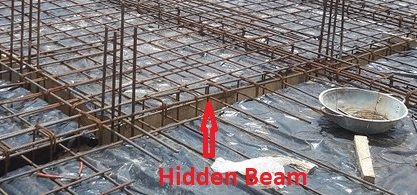If the depth of the beam in the slab is equal to the depth of the slab, it is known as a hidden beam or concealed beam. You can not see concealed beam after slab casting.

The normal beam has a larger depth than the slab but the concealed beam has the same depth as of slab. Like a normal beam, reinforcement detailing is separate from the concealed beam.
It is an RCC beam. A concealed beam is always provided within the depth of supporting slabs. In any circumstances, the depth of the hidden beam can not exceed the depth of the slab.
Concealed beams are very well known in building construction. It is a very important part of the frame structure.
For a normal building, there is no need to provide a hidden beam in the slab. But some building requires a particular type of design. To fulfill clients’ architectural requirements concealed beam is constructed in the slab.
Table of Contents
Why hidden beam are provided?
Hidden beams are provided to achieve the highest possible floor height to clear the way for utilities like; electromechanical ducting works like ducts, pipes, electrical wires, cable trays, etc.
Concealed beams also improve architectural aesthetic appearance by providing a neat and layered ceiling surface.
Advantages of Hidden Beams
- It is more feasible than the normal beam.
- It provides greater floor heights.
- It is more economical.
- It does not show in the slab.
Disadvantages of Hidden Beam
The main disadvantage of the concealed beam is that it has considerably low ductility due to the height reinforcement ratio which is provided to compensate for depth restriction specifically at column connection.
